
On September 10 a German friend with more than 7.900 birds WW came for an extended Usambara trip with me. It was basically the same trip I did with my friend Graham Ekins in August, the only difference was that we did the trip in reverse order for my English friend Joe Tobias to join us on the Usambara leg of the trip. I had asked my german friend if he was a Bird Photographer and he confirmed. However; when I was on the trip with Graham, he texted me and wanted advise on Bridge Cameras! It turned out that he never used his camera or took one picture max and he also ticked lifer on sound. Besides that, he did not have a clue about his target birds, so it turned out to be a very challenging trip. He had a target of 114 birds and in the end, we managed to get 93 of these targets. It was a relief, when Joe Tobias joined us since he was obviously a serious birder and knew his target birds.
Day 1, Tuesday September 10: Airport to Kiligolf.
I picked up my friend early in the morning and started driving home. We started ticking birds in the car: Pied Crow, Superb Starling, African Grey Hornbill, Spotted Palm Thrush, Red-billed Firefinch, Red-winged Starling and Black-headed Heron. We arrived home had breakfast and started ticking birds in my garden. Here are a few of the ones we registered: Speckled Mousebird, Vitelline Masked Weaver, Chestnut Weaver, Yellow-spotted Bush Sparrow, Scarlet-chested Sunbird, African Pied Wagtail, Yellow-breasted Apalis, Grey-backed Camaroptera and Rüppel´s Robin-Chat. In the afternoon, we took a walk on Kiligolf. Here are some of the species recorded: Little Sparrowhawk (In the Garden), Rattling Cisticola, White-browed Coucal, Long-tailed Fiscal, Pin-tailed Whydah, Purple Grenadier, Yellow-bellied Greenbul,Red-cheeked Cordon-Bleu, Red-eyed Dove, Ring-necked Dove, African Grey Flycatcher, Reichenow´s Seed-eater, Crested Francolin, Bronze Mannikin, Giant Kingfsiher, Black-headed Oriole, Sombre Greenbul,White-browed Srub-Robin, Hadada Ibis, Red-faced Cisticola, Brown-breasted Barbet, Pallid Honeyguide, Slate coloured Boubou, Tawny-flanked Prinia, Grey-headed Kingfisher, African Paradise Flycatcher and Blue-naped Mousebird.
Some Pictures from Day 1

Garden Lifer 143, Little Sparrowhawk, Tachyspiza minulla

White-browed Coucal, Centropus superciliosus
Day 2, Wednesday, September 11: Kiligolf, Sakila Hills, Usa River and Kiligolf.
We started the morning walk on Kiligolf. Here are some of the birds we observed: Violet-backed Starling, Red-faced Crombec, Chinspot Batis, Buff-bellied Warbler, African Palm Swift, White-bellied Go-away Bird, Common Greenshank, Pale White-eyed, Magpie Shrike, Yellow-billed Stork, Grey Heron, Purple Heron, Hamerkop, Squacco Heron, Little Egret, Hildebrandt´s Starling, Wattled Starling, Black-backed Puffback, Blue-capped Cordon-bleu, Spectackled Weaver, Orange-breasted Bushshrike, Brown-hooded Kingfisher, White-eared Barbet, Brown-crowned Tchagra, Malachite Kingfisher, Pied Kingfisher, Fork-tailed Drongo, Black Cuckooshrike, Collared Sunbird, Wire-tailed Swallow, Bown-backed Honeybird, Lizard Buzzard, Three-banded Plover, Southern Citril, Lesser Swamp Warbler, Northern Brownbul, Thick-billed Weaver, Cardinal Woodpecker, Augur Buzzard, Green-winged Pytilia, Variable Sunbird, Laughing Dove and Northern Grey-headed Sparrow.
We returned for breakfast had a little break and went to the wetlands below Sakila Hills: Here we added amongst others these species: Golden-breasted Bunting, African Sacred Ibis, Northern Fiscal, Intermediate Egret, Knob-billed Duck, White-faced Whistling Duck, African Jacana, African Swamphwen, Common Moorhen, Brown-throated Martin, Blacksmith Lapwing, Egyptian Goose, African Marsh Harrier, Little Grebe, Western Cattle Egret, White-backed Duck,African Spoonbill, Glossy Ibis and African Pipit.
On the way home for lunch, we stopped at a few spots and added Broad-billed Roller, Taveta Weaver and Senegal Lapwing. We relaxed a little after lunch and then went out on Kiligolf again around 16:30. Here are some of the new birds we registered: Nubian Woodpecker, African Pygmy Kingfisher, Nortern Red-fronted Tinkerbird, Red-backed Mannikin, Yellow-fronted Canary, Brubru, Amethyst Sunbird, Black Crake and Gabar Goshawk.
We returned home, freshened up, had dinner and retired early to bed.
Some pictures from Day 2:

Red-faced Cisticola, Cisticola erythrops

Red-cheeked Cordon-bleu, Uraeginthus bengalus

Malachite Kingfisher, Corythornis cristatus

Green Mamba, Dendroaspis angusticeps

African Grey Flycatcher, Bradornis microrhynchus, Endemic to NE Africa

Squacco Heron, Ardeola ralloides

Taveta Weaver, Ploceus castanaiceps, Endemic to N Tanzania and S Kenya

African Paradise Flycatcher, Tersiphone viridis

African Pygmy Kingfisher, Ispidina picta

Magpie Shrike, Lanius melanoleucus
Day 3, Thursday, September 12, Kiligolf, Masai Steppes, Shambalaya Dam, Kiligolf.
We left early and found a pair of Red-throated Twinspots in my garden before we reached the car. In Mererani we got the first House Crow of the trip. We started birding where the Tar road North of Mererani stops. Here are some of the birds recorded on the Masai Steppes: Tsavo Sunbird, Northern Crombec, Northern White-crowned Shrike, Lesser Masked Weaver, White-headed Mousebird, Yellow-bellied Eremomela, Pink-breasted Lark, Pringle´s Puffback, Grey Wren-Warbler, Southern Grosbeak Canary , Banded Parisoma, Kenya Sparrow, D´Arnaud´s Barbet, Pygmy Batis, Red-fronted Prinia, Crimson-rumped Waxbill, Eastern Violet-backed Sunbird, Namaqua Dove, Red-billed Oxpecker, Emerald-spotted Wood Dove, Black-winged Kite, Black-throated Barbet, Lesser Honeyguide, Black-necked Weaver, Hunter´s Sunbird, Pygmy Falcon, Greater Honeyguide, African Hawk-Eagle, Eastern Chanting Goshawk, African Crake, Somali Bunting, Lesser Striped Swallow, Straw-tailed Whydah, Fischer´s Starling, Rosy-patched Bushshrike, Bare-eyed Thrush and White-bellied Canary. My German friend did not need the Black-capped Social Weaver, so we saved quite some time and were home quite early for some relaxing in the garden.
Some pictures from Day 3:

Pink-breasted Lark, Calendulauda poecilosterna, Endemic to NE Africa

African Crake, Crecocips egregia

Common Greenshank, Tringa nebularia

Somali Bunting, Emberiza poliopleura, Endemic to NE Africa

Rosy-patched Bushshrike, Telephorus cruentus, Endemic to NE Africa

White-bellied Canary, Crithagra dorsostriata, Endemic to NE Africa
Day 4, Friday, September 13: Arusha National Park
We were at the gate of the park just before 08:00 in the morning and started ticking species on my normal route towards the museum. Here are some of the birds we recorded: Common Waxbill, Singing Cisticola, African Stonechat, Grey Crowned Crane, Cape Robin-Chat, Narina Trogon and Scaly Spurfowl. On the two forks around Ngurduto crater, we added Eastern Bronze-naped Pigeon, Olive-headed (Stripe-faced) Greenbul, Retz´s Helmetshrike, Grey-headed Nigrita, Hartlaub´s Turaco, Silvery-cheeked Hornbill, Broad-ringed White-eye, Crowned Eagle, Olive Sunbird, Cinnamon-chested Bee-eater, Lemon Dove. We drove from the museum and towards the lakes. Here are some of the birds we registered on the way and around the lakes: Black-crowned Tchagra, African Hoopoe, Sentinel Lark, Black-crowned Night Heron, Winding Cisticola, Whinchat, Cape Teal, Ashy Cisticola, Ruff, Banded Martin, Southern Pochard, White-backed Vulture, African Fish Eagle, Baglafecht Weaver, Lanner Falcon, Red-billed Teal, a few lLesser Flamingos, Long-billed Pipit, African Harrier-Hawk, and White-fronted Bee-eater. We drove towards Mount Meru. Here are some of the birds we registered on the way up to and down from the Waterfall: White-necked Raven, Little Greenbul, African Dusky Flycatcher, Bar-tailed Trogon, Mountain Buzzard, Waller´s Starling, Black-headed Mountain Greenbul,Abysinnian Crimsonwing, White-starred Robin,Thick-billed Seed-eater, Olive Woodpecker, Black Daw-wing, Kenrick´s Starling, Brown Woodland Warbler, Streaky Seedeater and on the little Serengeti plains just before the exit: Marabou Stork.
We left the park and headed home.
Some pictures from Day 4

Scaly Spurfowl, Pternistis squamatus

Lanner Falcon, Falco biarmicus

Cape Teal, Anas capensis

Black-headed Mountain Greenbul, Arizelocichla nigriceps, Endemic to N Tanzania and S Kenya
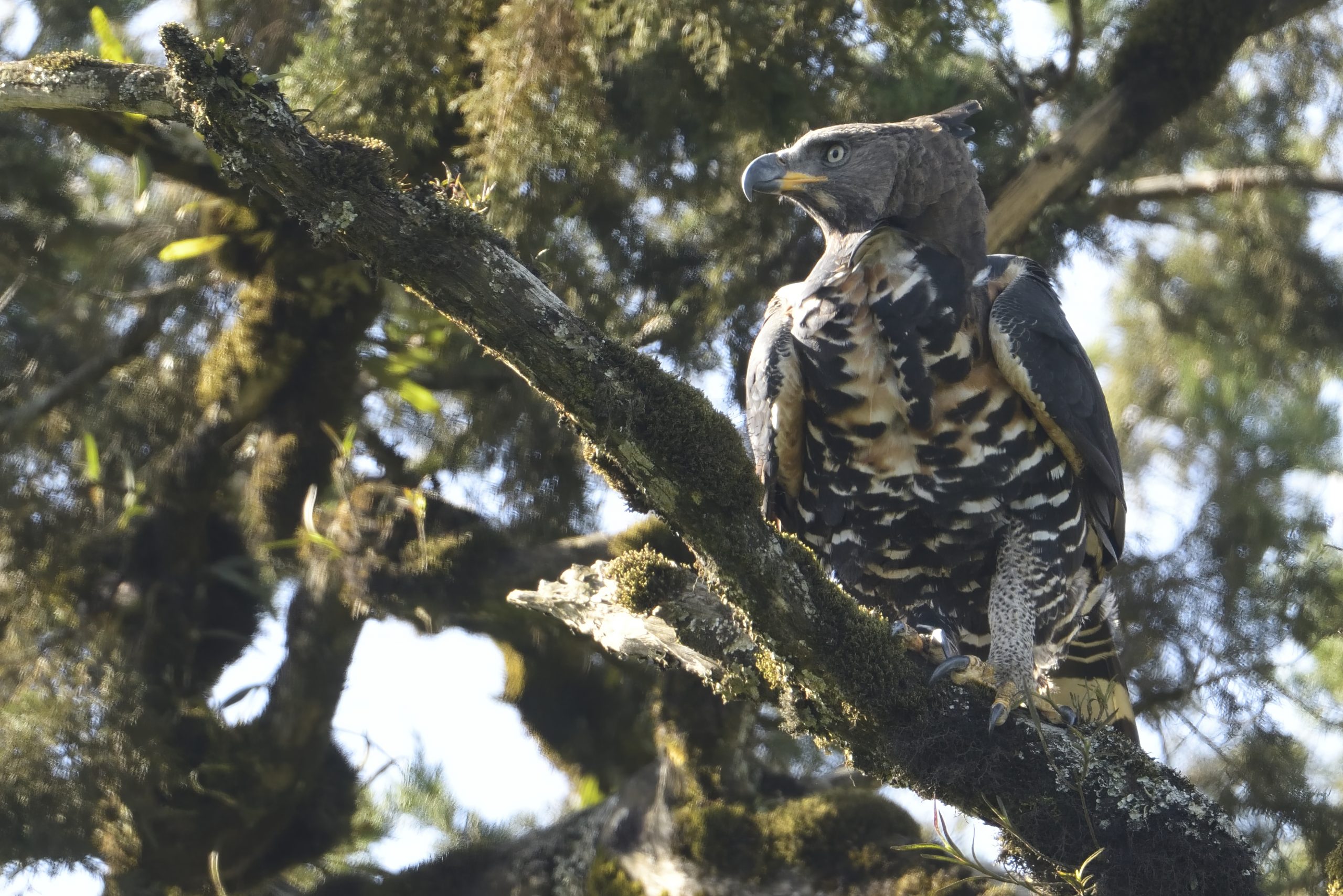
Crowned Eagle, Stephanaoatus coronatus

Brown Woodland Warbler, Phylloscopus umbrovirens, Endemic to NE Africa
Day 5, Saturday, September 14, 2024, Usa River, Ngarasero Lodge and Kalinga Forest, Usa River
We dipped on the Pangani Longclaw in Arusha NP, but found it easy in Usa River, Next stop, Ngarasero Lodge. Here are some of the birds recorded :Little Rush Warbler, Black-throated Wattle-eye, African Black Duck and Malagasy Pond Heron. Then onwards to Kalinga Forest where we added: Crowned Hornbill, Placid Greenbul, Green Malkoha, Ble-mantled Crested Flycatcher, Black-fronted Bushshrike, Forest Batis and Village Weaver.
Some pictures from Day 5:
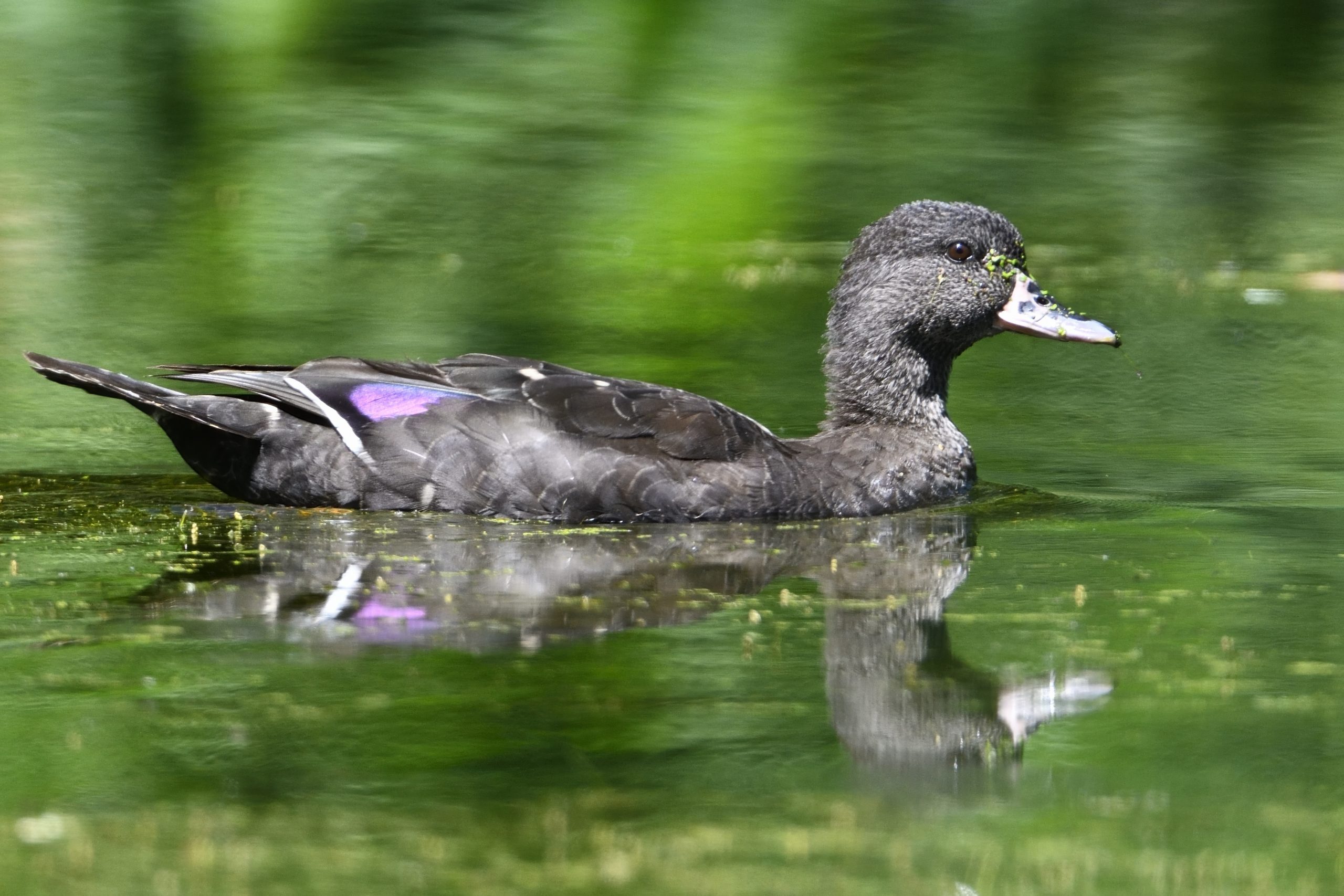
African Black Duck, Anas sparsa

Forest Batis, Batis mixta, Endemic to coastal E Africa
Day 6, Sunday, September 15: Lark Plains, Lengijave, Lake eluanata and Karatu
We heard a Verreaux´s Eagle-Owl early morning before we left for Lark Plains. We turned of The main road around 07:40 and started ticking birds toward the Beesley´s Lark Spot: Capped Wheatear, Taita Fiscal, Red-capped Lark, Chestnut-bellied Sandgrouse and Beesley´s Lark. We started driving towards the dry Acacia Forest near the Masai Boomas and picked up: Fawn-coloured Lark, Greater Kestrel, Red-throated Tit and Pygmy Falcon. At our breakfast spot and the walk in the Acacia Forest, we added: Grey-capped Social Weaver, Northern Red-billed Hornbill, Spackle-fronted Weaver, Red-fronted Barbet, Banded Parisoma, White-bellied Canary and Red-and-yellow Barbet. Next stop where Lengijave. There we found Abyssinian (Schalow´s Wheatear, Bronze Sunbird, Black Bishop,Horus Swift, Lyne´s Cisticola (our target), Kenya Sparrow, African Firefinch and White-fronted Bee-eater. We had lunch and were soon underway to Lake Eluanata. There we found: Black-chested Snake Eagle, Gull-billed Tern, Chestnut Sparrow, Marsh Sandpiper, Little Stint, Common Sandpiper, White-headed Buffalo Weaver, Rufous-tailed Weaver, Pangani Longclaw, Northern Pied Babbler, Eastern Grey Woodpecker and Speckled Pigeon. We continued to Karatu where to my dismay our normal lodging were not of high enough standard for my German friend, so we had to find another spot for him to sleep.
Some pictures from Day 6:

Capped Wheatear, Oenanthe pileata
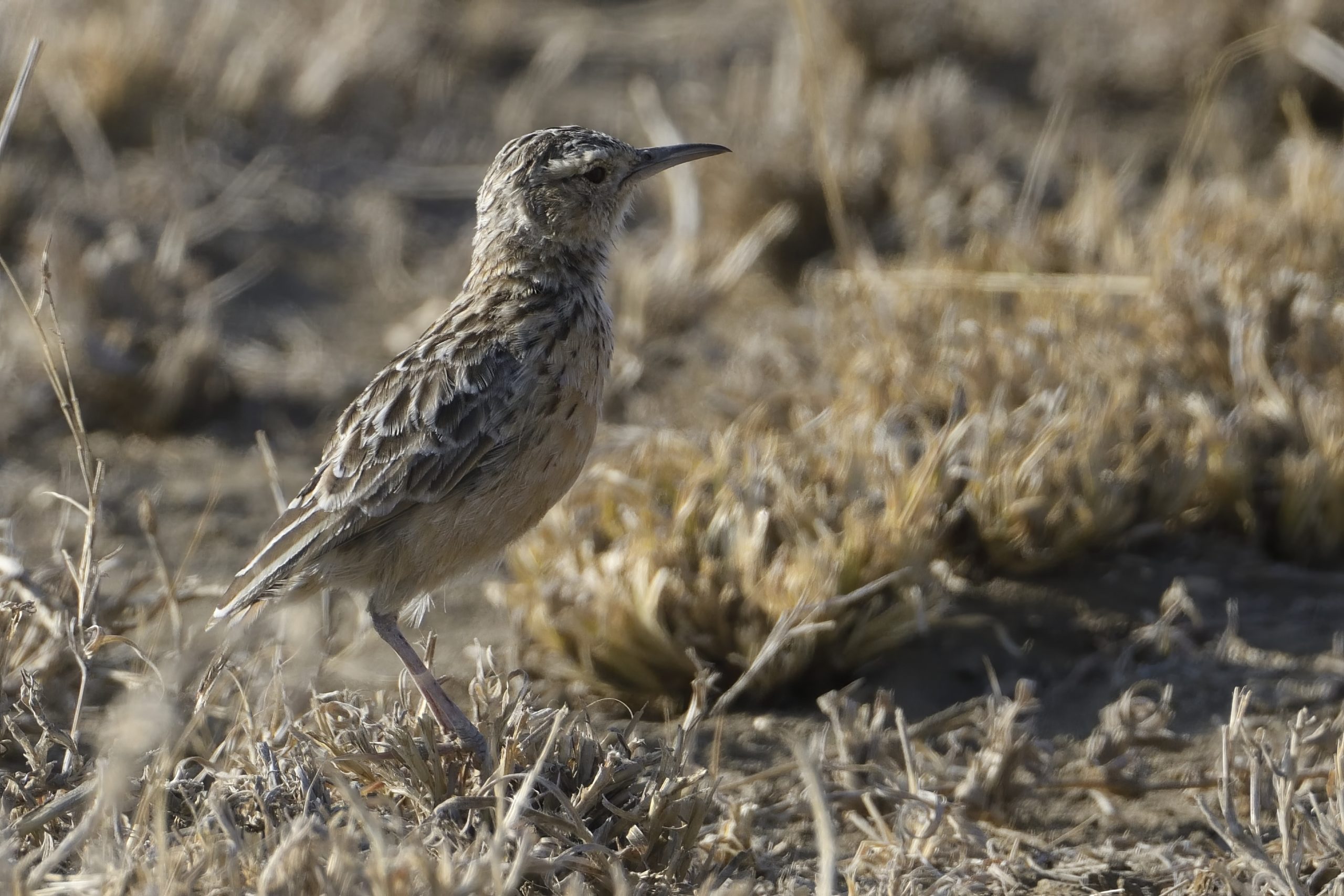
Beesley´s Lark, Chersomanes beesleyi, Endemic to a small area northe of Arusha, Tanzania

Chestnut-bellied Sandgrouse, Pterocles exustus

Lyne´s Cisticola, Cisticola distinctus, Endemic to E Africa
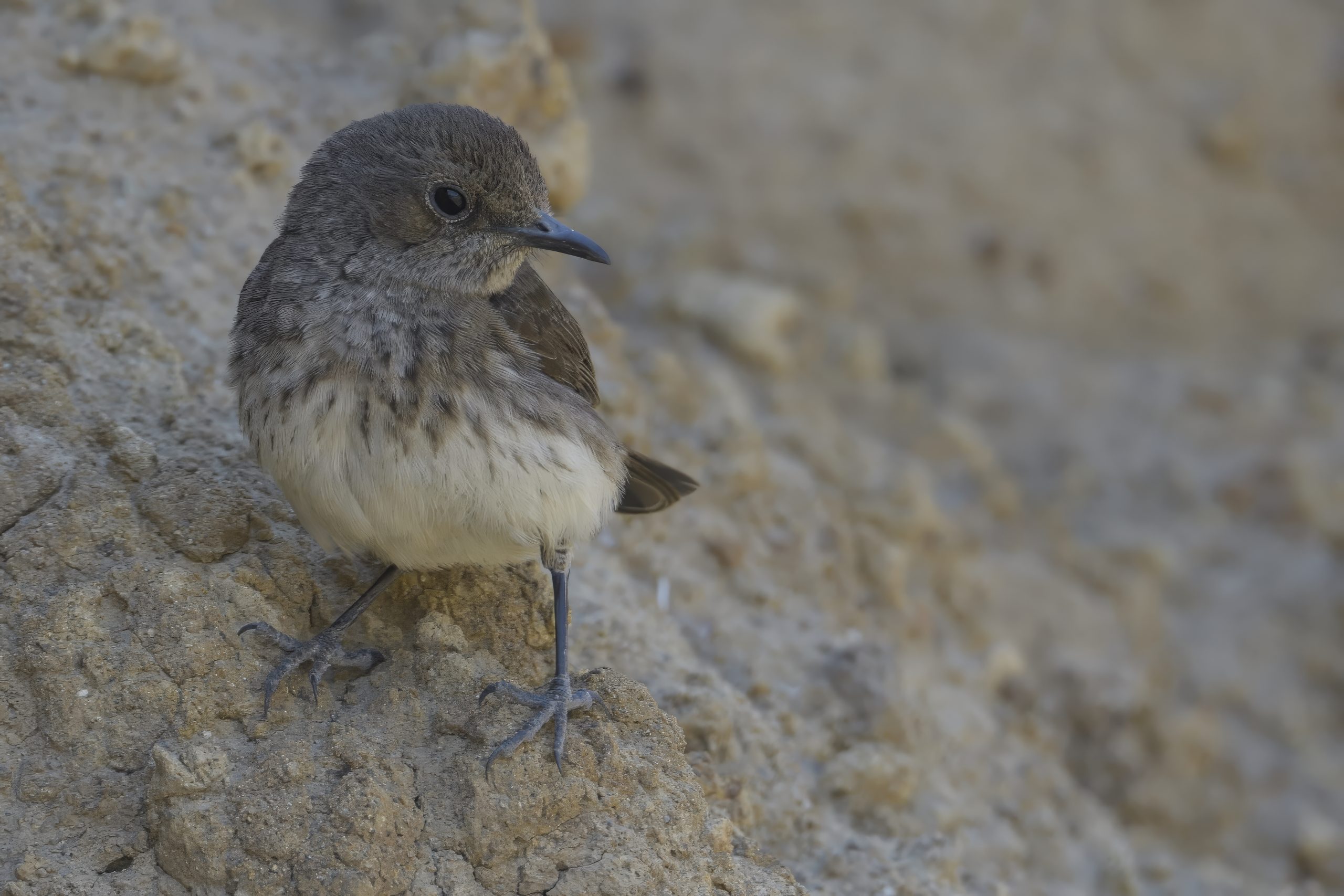
Abyssinian (Schalow´s) Wheatear (Female), Oenanthe lugubris, schalowii

Abyssinian (Scalow´s) Wheatear (Male), Oenanthe lugubris, schalowii

Variable Sunbird, Cinnyris venustus

White-fronted Bee-eater, Merops bullockoides

Pangani Longclaw, Macronyx aurantiigula, Endemic to NE Africa

Northern Pied Babbler, Turdoides hypoleuca, Endemic to E Africa
Day 7: Sunday, September 16: Karatu, Endoro Trail, The road to the entrance to Tarangire to Babati.
We only had 5 km to the start of the Endoro trail. On the way, we found a flock of Fischer´s Lovebird´s. We started at the trail at around 07:30. Here are some of the birds, we encountered: White-eyed Slaty Flycatcher, Mbulu White-eye, Purple-throated Cuckooshrike, Klaas´s Cuckoo, Brown-backed Woodpecker, Moustached Tinkerbird, African Hill Babbler, Eastern Crested Guineafowl, Hildebrandt´s Spurfowl, Brown-headed Apalis, Schalow´s Turaco, White-browed Robin-Chat, White-tailed Blue Flycatcher, Eastern Double-collared Sunbirds, Grey-capped Warbler, Bronze Sunbird, Baglafecht Weaver, Crowned Eagle and Golden-winged Sunbird. We drove towards Tarangire, where we were supposed to sleep. We had already found some of our targets at Lake Eluanata and we got the rest on the road to the gate off the park. Unfortunately my German friend were happy so he did not want to go inside one of my favourite parks for birding. Here are the birds we saw on the way to the gate: Yellow-collared Lovebird, Swahili Sparrow, White-browed Sparrow-Weaver, Ashy Starling and Silverbird. We continued to Babati, checked in and went out for dinner.
Some pictures from Day 7:

Brown-headed Apalis, Apalis alticola

Southern Citril, Crithagra hyposticta, Endemic to SE Africa

White-eyed Slaty Flycatcher, Melaenornis fischeri, Endemic to E and C Africa
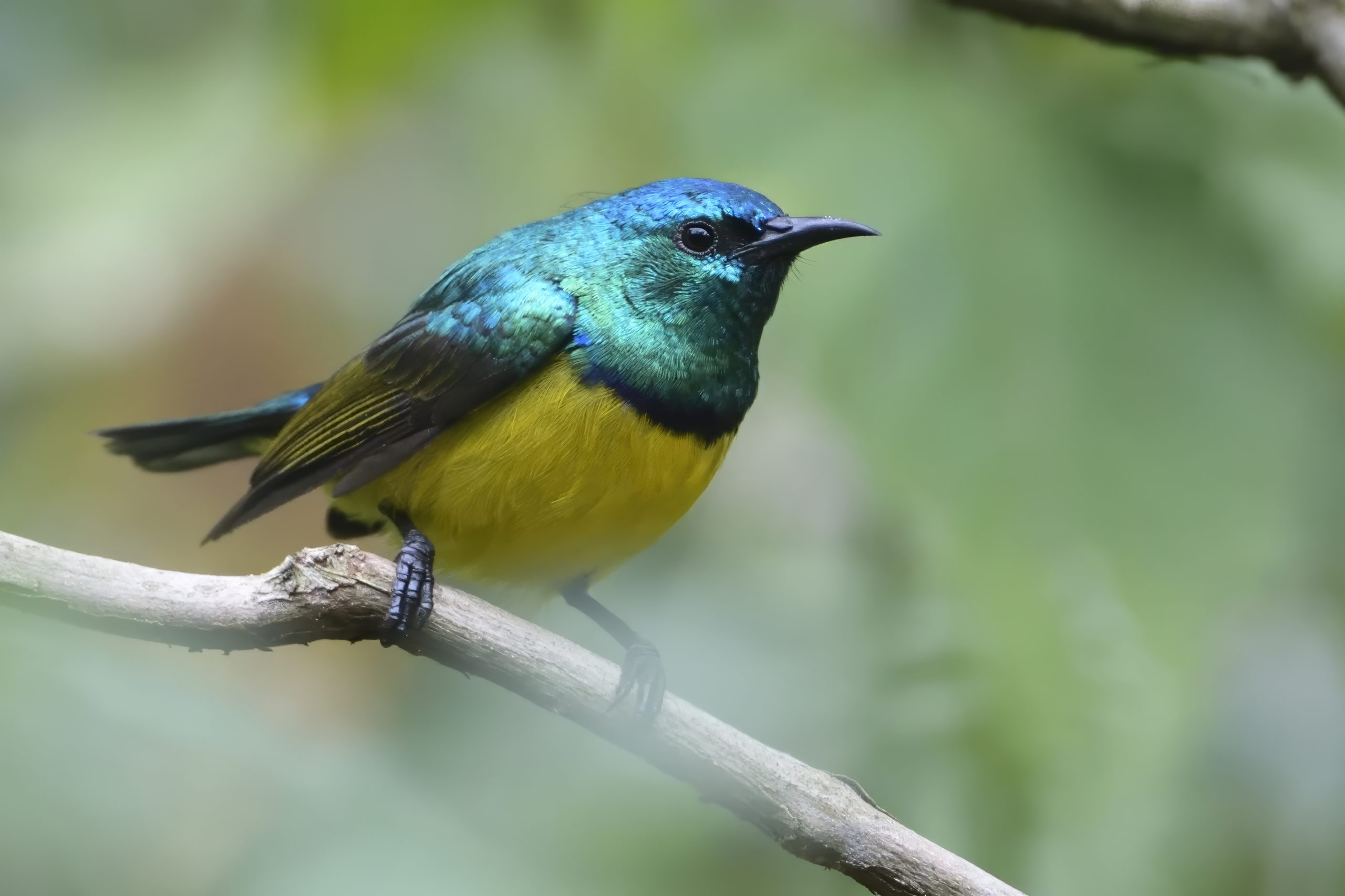
Collared Sunbird, Hedydipna collaris

Grey-capped Warbler, Eminia lepida, Endemic to NE Africa

Eastern Double-collared Sunbird, Cinnyris mediocris, Endemic to E Africa

Brown-backed Woodpecker, Dendropicos obseletus

Baglafecht Weaver, Ploceus baglafecht

Bronze Sunbird, Nectarina kilimensis

Yellow-collared Lovebird, Agapornis personatus, Endemic to E Africa

Northen White-crowned Shrike, Eurocephalus ruppeli, Endemic to NE Africa
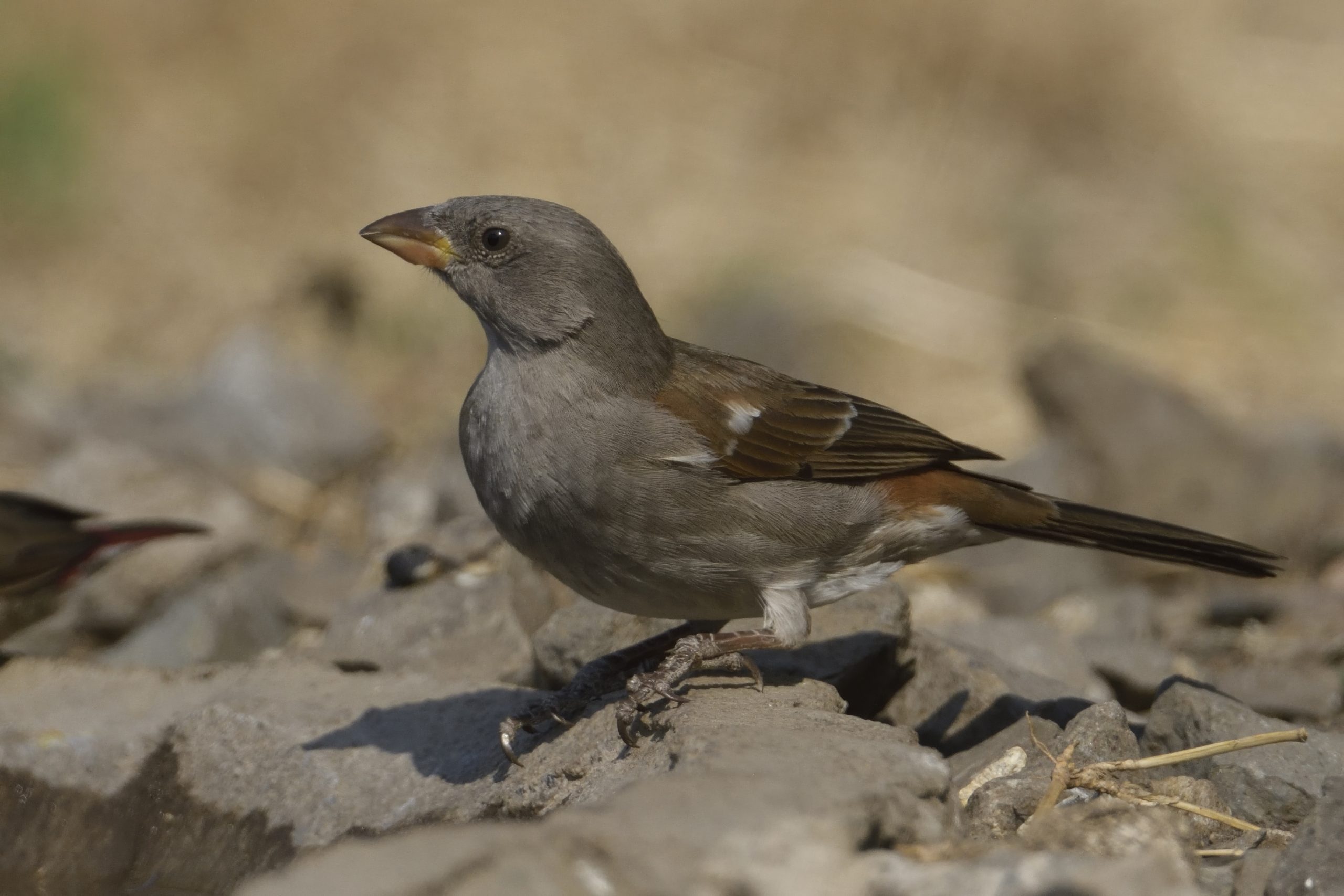
Swahili Sparrow, Passer suahelicus

Agy Starling, Lamprotornis unicolor, Endemic to Tanzania and Masai Mara, Kenya

Superb Starling, Lamprotornis superbus, Endemic to NE Africa
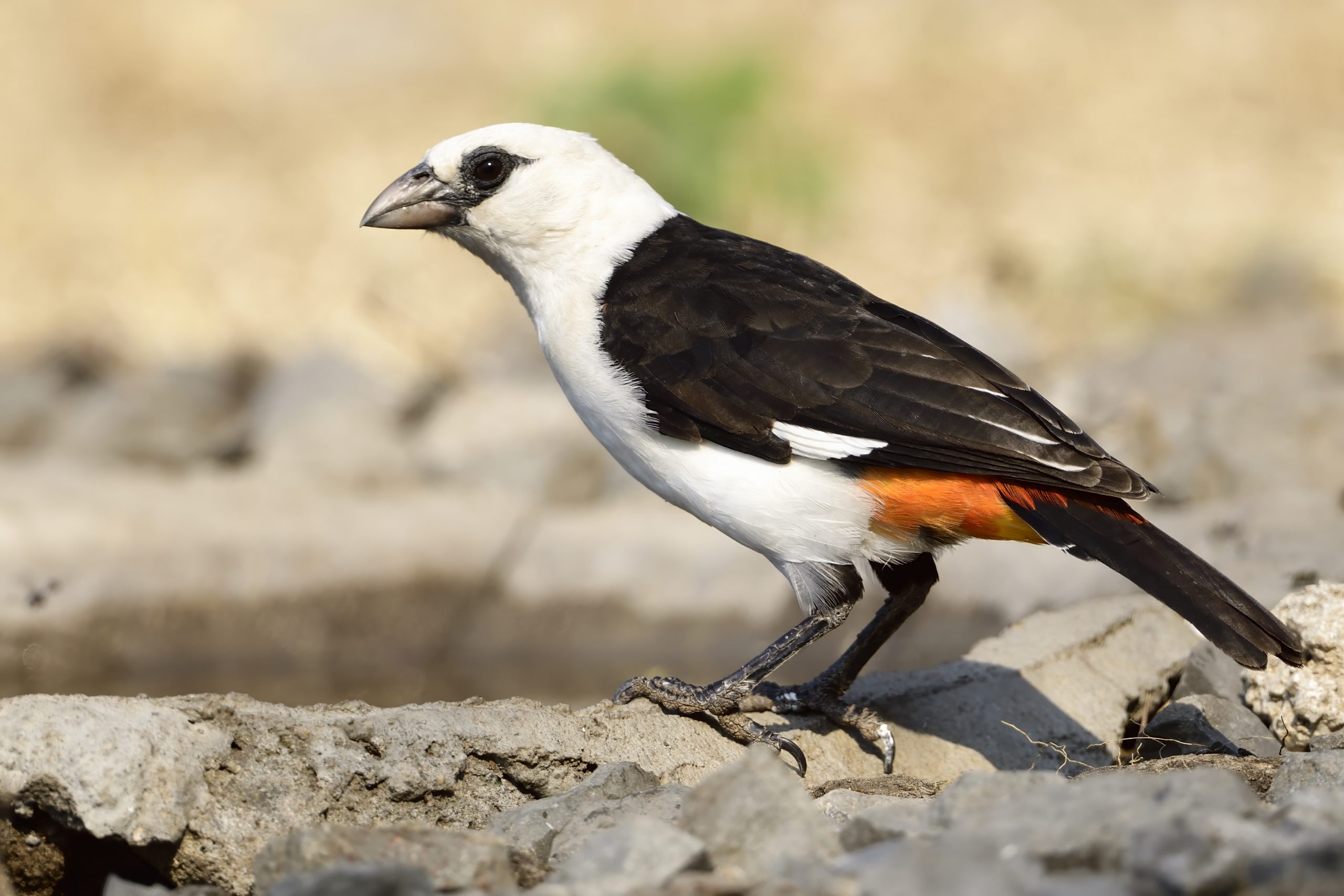
White-headed Buffalo Weaver, Dinemellia dinemelli, Endemic to NE Africa
Day 8; Monday, September 17; Babati to Mbulu Mountains and a long drive to Gairo
We started early up the Mountain and met Karoli, the local ranger at the forest edge. We did a quick search and very quickly found one Olive-Flanked Ground Robin of the race Mbulensis. This was our only target bird, but we also added Tacazze Sunbird to our list, we drove back to Babati and towards Gairo via Dodoma. Once we arrived in Gairo, we checked into our hotel and went to eat. Martin had found a local place last time were Graham and I had excellent Beef Mishkaki (Beef Skewer). Obviously my German friend were not impressed by a local restaurant and asked if there were not a real restaurant in Gairo. I replied, it is 6:30 at night. I know of a restaurant and we can go there if you are willing to wait 2 hours for your meal. Reluctantly he ordere the same as I and before I knew it, he orderer extra Mishkakis :-).
We returned to the hotel and had an early night.
One picture from Day 8:

Olive-flanked Ground Robin, Dessornis anomalus, Localised endemic to SE Africa
Day 9: Tuesday, September 18: Gairo to Ukaguru Mountains to Hondo Hondo in the Kilombero Valley.
We started early up the mountain. To my surprise they had made a lot of improvements to the road. We had quite a few targets up there. Here are the birds we registered: Trilling Cisticola, Morau´s Sunbird, Livingstone Turaco, Grey Cuckooshrike, Dark Batis, Rubeho Warbler (I still do not have a picture of this bird. This time it were singing just a couple of meters from me. I got excellent views, but no pictures. Next Time!). Fülleborn´s Boubou, Chapin´s Apalis and Yellow-throated Mountain Greenbul. We dipped on the Rubeho Akalat and on the way down Black-lored Cisticola (dipped with Graham as well. Time of year?) and Uhehe (Southern Fiscal). We pushed on and while driving through Mikumi National Park, we saw Bateleur, Trumpeter and Pale-biled Hornbill. We reached Hondo Hondo camp in the early afternoon. We called the local ranger and were soon on our way to Magambero Forest. Here we found White-winged Widowbird, Palm-nut Vulture, Eastern Golden Weaver, Coppery-tailed Coucal, Kretschmer´s Longbill, Fiery-necked Nightjar, White-browed Robin-Chat, 2 Dwarf Bitterns and finally Pel´s Fishing Owl (EA Lifer for me). We returned to camp and had a lovely meal and retired to our tents.
Some pictures from Day 9:

Bar-throated Apalis, Apalis thoracica, race Murina.

Dark Batis, Batis Crypta, Endemic to Eastern Arc Mountains of Tanzania and Northern Malawi

Pel´s Fishing Owl, Scotopelia peli (EA lifer for me)
Day 10, Thursday, September 19, 2024. Hondo Hondo – Ifakara, Miombo Woodland North of Mikumi and Tan-Swizz, Mikumi
We heard an African Wood Owl calling early morning. We searched for the Lesser Seedcracker in the morning, but no luck: Instead we found: Magpie Mannikin, Short-winged Cisticola, Orange-breasted Waxbill, Blue-spotted Wood Dove, Southern Black Flycatcher and Ayre´s Hawk-Eagle. We then pushed on to Ifakara for the 3 endemics there. Again my guide and I had a misunderstanding on where to go so we ended up at my normal spot where we found the 3 endemics in no time (Kilombero and White-tailed Cisticola and Kilombero Weaver). We returned to Hondo Hondo and the boys went another time in search for the Lesser Seedcracker without any luck. I enjoyed my packed lunch and photographed Retz´s Helmetshrike and Black-headed Oriole. The boys came back and we headed for the Miombo Woodland just North of Mikumi: Here are some of the birds we observed that afternoon: Miombo Blue-eared Starling, Yellow-throated Bush Sparrow, Stierling´s Wren Warbler, White-breasted Cuckooshrike, African Golden Oriole, Speckle-throated Woodpecker, Scaly-throated Honeyguide, Cinnamon-breasted Tit, Livingstone Flycatcher, Neddicky, Racket-tailed Roller, Red-headed Weaver, Greater Blue-eared Starling, Arnot´s Char, Cardinal Woodpecker and Brown-headed Parrot. We checked in at Tan-Swizz in Mikumi and had a nice dinner.
Some pictures from Day 10:

Short-winged Cisticola, Cisticola brachypterus

Magpie Mannikin, Spermestes fringilloides

Common Waxbill, Estrilda astrild
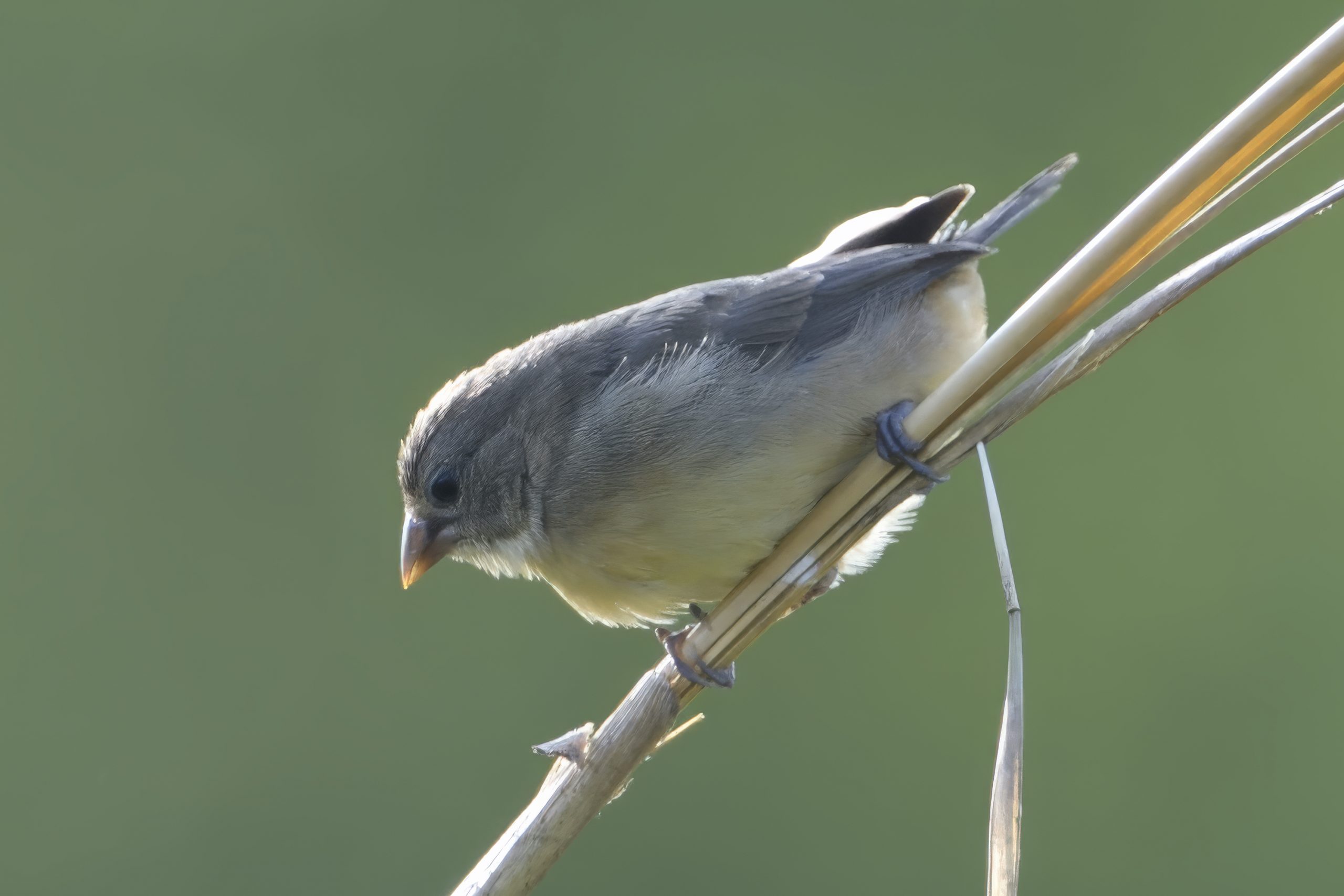
Orange-breasted Waxbill (Juvenile), Amandava subflava
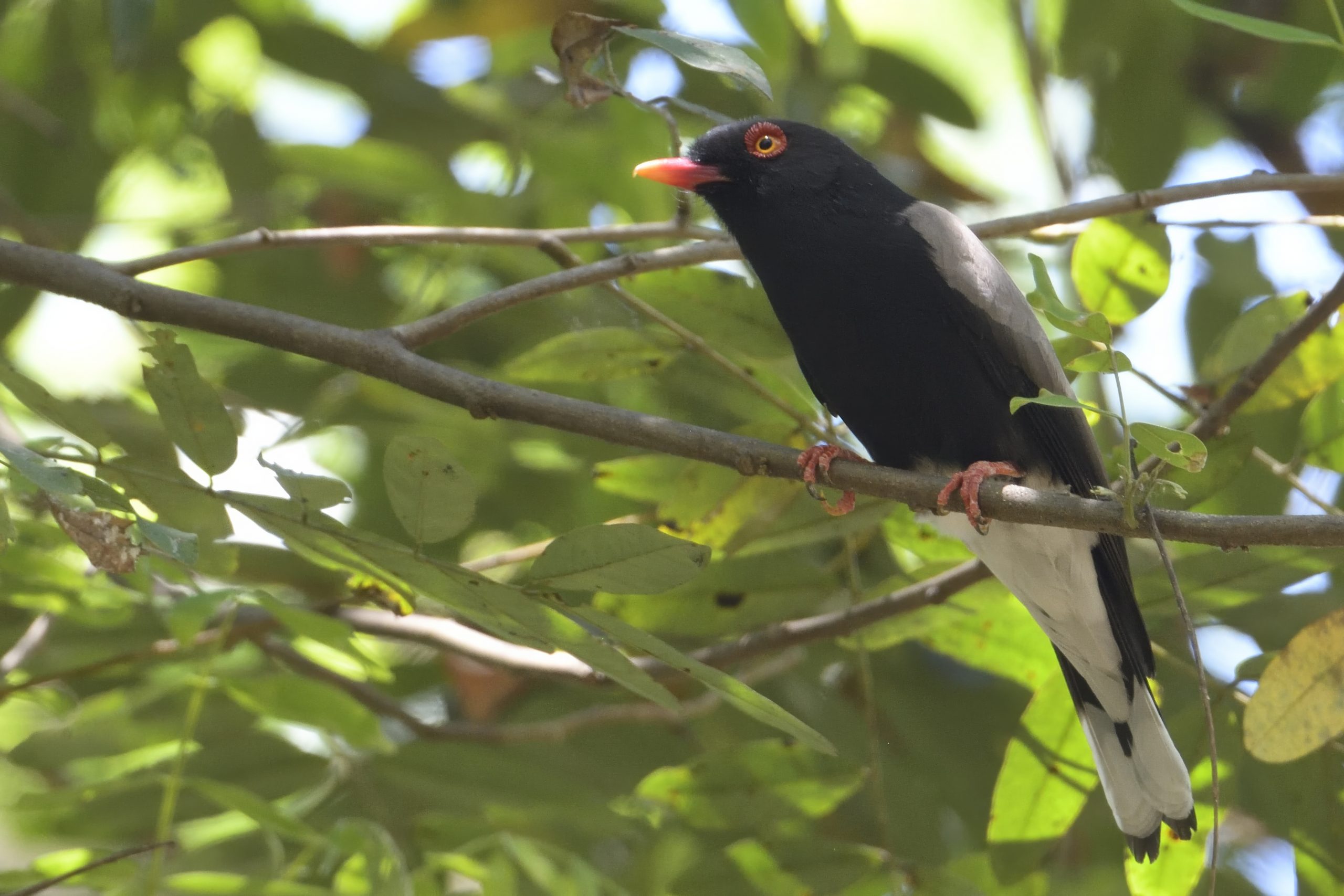
Retz´s Helmetshrike, Prionops retzi

Black-headed oriole, Oriolus larvatus

White-breasted Cuckooshrike, Ceblepyris pectoralis

Black Cuckooshrike (Female), Campephaga flava

Cinnamon-breasted Tit, Melaniparus Pallidiventris

Red-headed Weaver, Anaplectes ruriceps
Day 11, Friday, September 20, 2024: Miombo Woodland North of Mikumi
We started early in the Miombo Woodlands. Here are some of the new birds we registered: Collared Palm Thrush in camp), Hofmann´s Sunbird, Black-crowned Tchagra, Green-capped Eremomela, Violet-backed Starling, Bearded Woodpecker, Golden-tailed Woodpecker, Black-collared Barbet, Kurrichane Thrush, Crested Barbet, Yellow-fronted Tinkerbird and very good views of a surprise Lesser Seedcracker. We returned to camp. Got pictures of Blue Waxbill, Greater Honeyguide and Scarled-chested Sunbird in camp before we headed back to the Miombo Woodland in the afternoon. Here are some of the new birds recorded: Shikra, Red-necked Spurfowl, Common Scimitarbill, Black-and-white Shrike Flycatcher, Dark-chanting Goshawk and Red-winged Prinia. We returned to camp had a nice meal and retired early to bed.
Some pictures from Day 11

Blue Waxbill, Uraeginthus bengalus

Scarlet-chested Sunbird, Chalcomitra senegalensis

Greater Honeyguide, Indicator indicator

Lizard Buzzard, Kaupifalco monogrammicus

African Harrier-Hawk, Polyboroides typus

Scaly- throated Honeyguide, Indicator variegatus

Pale Batis, Batis soror

Red-throated Twinspot, Hypargos niveoguttatus

Brown-headed Parrot, Poicephalus cryptoxanthus
Day, 12, Saturday, September 21, 2024: Tanz Swizz via Mikumi National Park to Ngezi Lodge, Morogoro.
We drove towards the Mikumi NP entrance gate. I saw in my mirror a very aggressive bus driver. He started honking and blinking when he were 500m behind me inside the major road going through the National Park park. Suddenly some Zebras decided to cross the road and of course I stopped. The bus driver could not overtake since a huge truck were coming the opposite way also stopped for the Zebras. The bus were too close to stop and he rammed me from behind. I parked the car and approached him. He and the passengers were yelling at me in Swahili. My guide approached them and they had a go at him as well. I decided the situation were becoming out of hand and ordered my guide inside the car. I just drove off. The bus driver were running after me and actually hit me through the window. I just drove on and came to the entrance to the National Park. I met a ranger there that had witnessed the entire scene. He said I had to go back to the accident site. I very reluctantly went back and spoke with the police and expected to give a report as I did. Then to my surprise, I had to go to the police station and sign another report. Things are not happening fast in TZ, so I waisted a lot of time. The damage to my car were not that big. I believe the bus driver had to spend the night in Jail in Mikumi that day (at least some consellation). It is almost impossible to claim anything from the insurance company, so in hindsight, I should have just continued. This entire episode delayed us by 4 hours and we were not inside the park before around 11:45. I had warned my German friend that the Mikumi NP, I avoid because the lack of interesting bird. I had to admit that I had seen Black Coucal there a few times. He insisted. The entire park were burned out and we managed to eak out a few birds: Southern Ground Hornbill, Saddle-billed Stork, Collared Pratincole, Chestnut-backed Sparrow-Lark, European Bee-eater, Yellow-billed Oxpecker, Black-lored Babbler and Black Crake. We then drove on to Ngezi Camp Site in Morogoro and stayed the night there.
Some pictures from Day 12.

The damage to my car

Soutern Ground Hornbill, Bucorvus leadbeateri

Saddle-billed Stork (Juvenile), Ephippiorhynchus senegalensis

Chestnut-backed Sparrow-Lark, Eremopterix leucotis

Collared Pratincole, Glareola pratincola

Black Crake (Juvenile), Zapornia flavirostra

Black Crake, Zapornia flavirostra

Greater Blue-eared Starling, Lamprotornis chalybaeus

Black-lored Babbler, Turdoides sharpei, Endemic to East Africa
Day 13, Sunday, September 22, 2024: Bondwa Peak Trail Uluguru Mountains, Morogoro.
We left the Nguzo Camp quite early and I were able to drive all the way to Morningside. Then a Boda Boda (Motorcycle taxi). Shuttled us up the last 10 minutes to the start off the trail. Where we parked the car, we had overflying Slender-billed Starling, once at the head of the trail, I recorded Striped Pipit, Trilling Cisticola and Jameson´s Firefinch. It is quite a walk to reach the forest, but it yields some nice birds like Bertram´s Weaver. I also recorded the recently split Red-throated Rock Martin. I am 64 and my previous English friend were 74 (and a mountain goat). I was wearing my normal flip flops, My German friend wore what he called his 4WD shoes. I think he had put them in super low gear, because he were extremely slow. He walked with my guide and at one stage I had to wait half an hour and again half an hour when we entered the forest. In the forest we started ticking birds: Evergreen Forest Warbler, Red-capped Robin-Chat, Barred Long-tailed Cuckoo, Trumpeter Hornbill, Livingstone Turaco and Little Greenbul. My friend asked when we should try for the Uluguru Bushshrike. I tried to tell him that it does not appear on that side of the mountain and I had actually checked with Neil Baker first. There was one dubious record on e-bird though. I told him it is not on this side of the mountain. He said I am a professor in Biology and I replied that I am a realist and I know my birds. He had to stop for every bird and ask have we seen this before. Due to delay and the German “besservisser” mentality, I had enough and decided to leave him with my guide to look for the non existent Uluguru Bushshrike while I continued uphill. I had never been higher than 1800 meters, but thought the top were at 2030 meters above sea level, but it turned out to be 2.170 meters above sea level. I had some wonderful birding on my own all the way to the top (in my flip flops). I recorded at least 15 Loveridge´s Sunbirds. Uluguru Greenbul, Shelley´s Greenbul, Dark Batis, Yellow-throated Woodland Warbler, Olive Sunbird, White-starred Robin, Fülleborn´s Boubou. I heard the Winifred´s Warbler and I finally reached the top 140 meter higher than anticipated. On my way down, I met my guide and German friend at 2.000 meters. They had seen some good birds too. On my way down to the edge of the forest, I recorded Red-faced Crimsonwing, Moustached Tinkerbird, Trilling Cisticola, Black-fronted Bushshrike, Green Barbet, the undescribed Thrush in clear view, but unfortunately did not get a picture, Bar-tailed Trogon, Bar-throated Apalis race Uluguru. I birded with my friend part of the way, but he were too slow for me having to look at all the birds we had already recorded, so when I came to the edge of the forest, I had to wait another half an hour for them to join me. I continued to the car and had another half an hour wait. I do not walk fast when I am birding and my English friend (74)totally out walked me on my previous trip, but I had to wait another half an hour by the car for them to catch up. We drove down to camp, had dinner and retired early to bed.
Some pictures from Day 13:
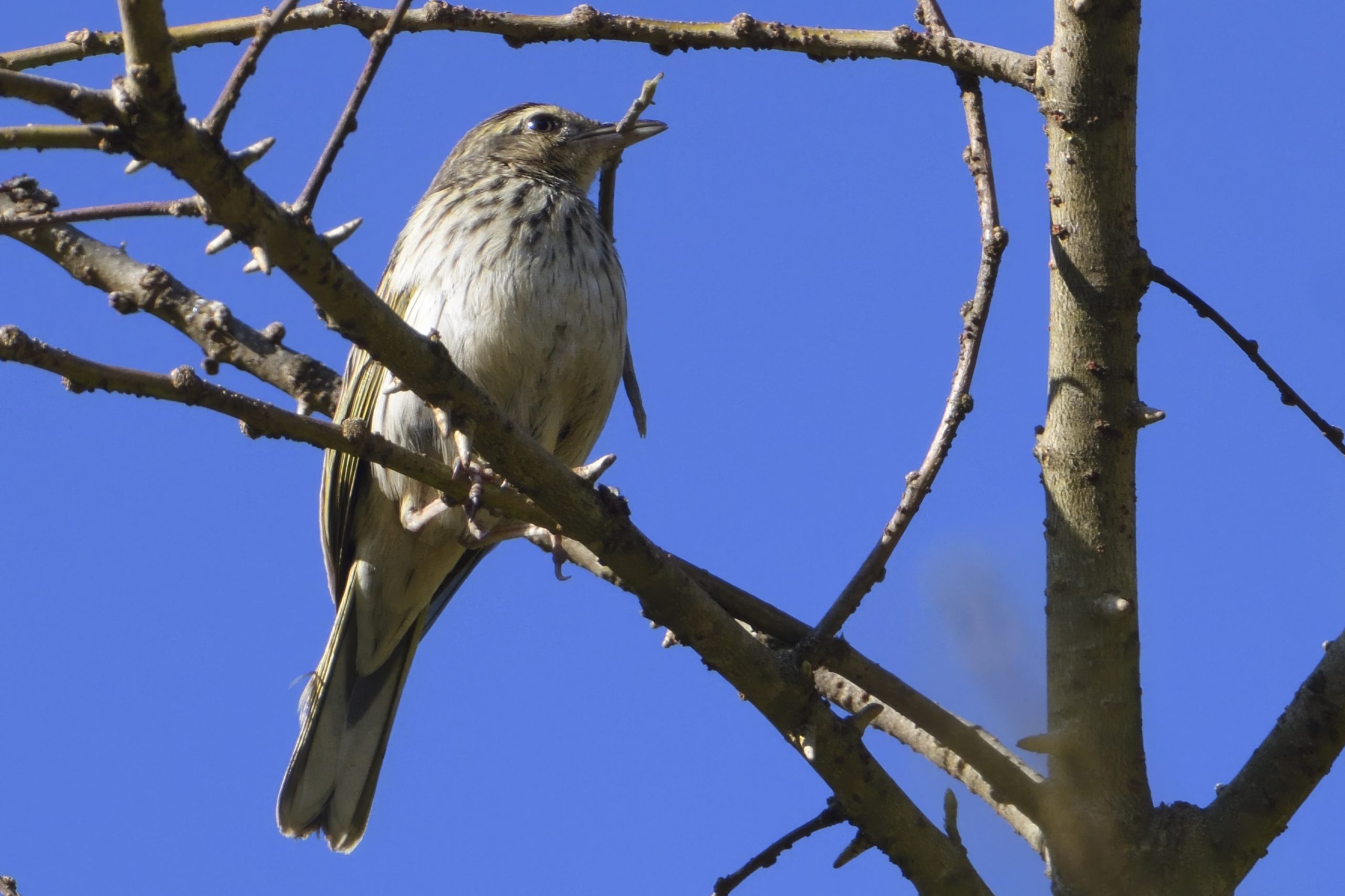
Striped Pipit, Anthus lineiventris

Trilling Cisticola, Cisticola woosnami

Bertram´s Weaver, Ploceus bertrandi, Endemic to highlands of SE Africa

Loveridge´s Sunbird, Cinnyris loveridgei, Endemic to Uluguru Mountains, Tanzania

Loveridge´s Sunbird (Female), Cinnyris loveridgei, Endemic to Uluguru Mountains, Tanzania
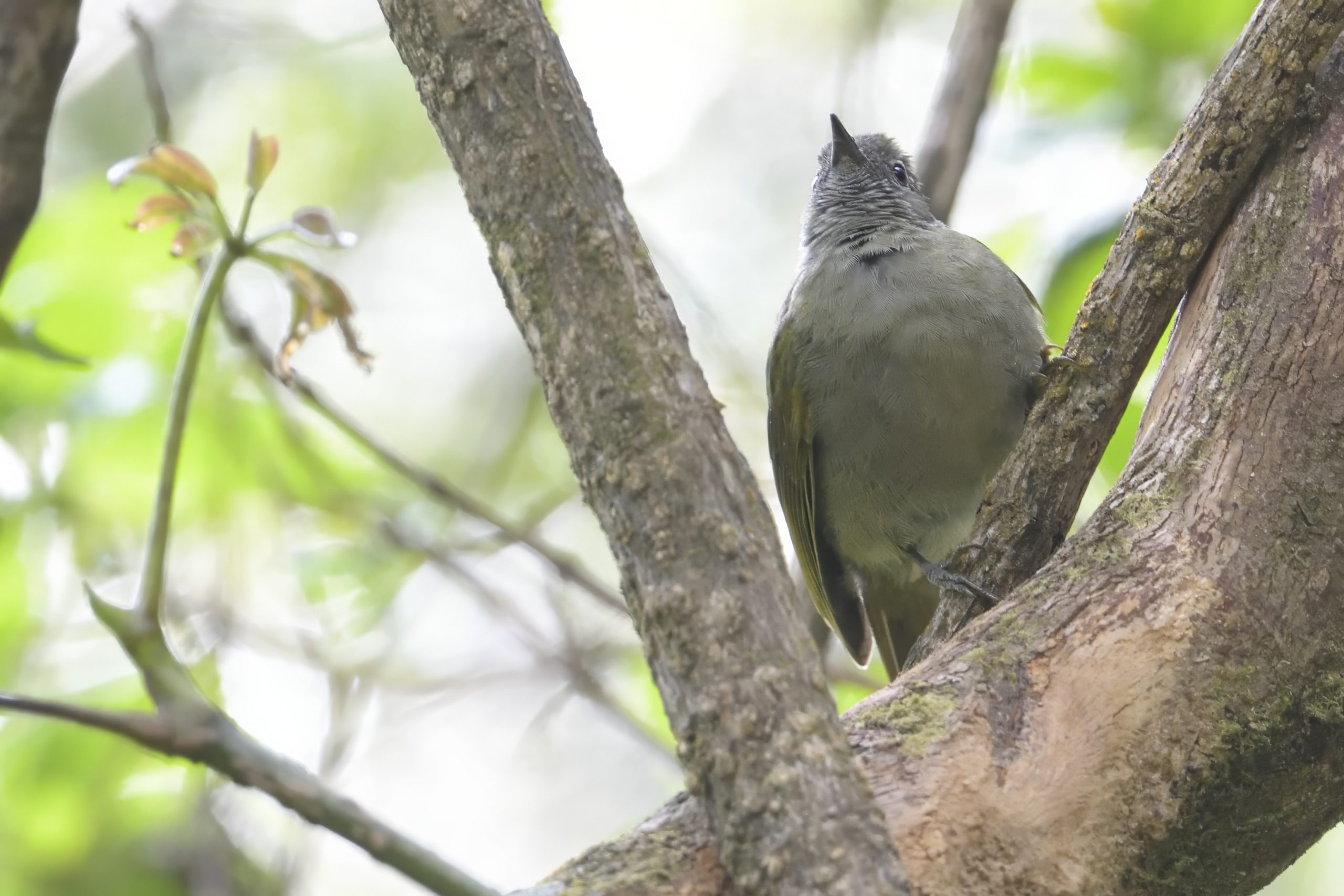
Shelley´s Greenbul, Arizelocichla masukuensis, Endemic to Eastern Arc Mountain of TZ and N Malawi

Yellow-throated Woodland Warbler, Phylloscopus ruficapilla

Dark Batis (Female), Batis crypta, Endemic to Eastern Arc Mountains of Tanzania and N Malawi

Uluguru Mountain Greenbul, Arizelocichla neumanni, Endemic to Uluguru Mountains, Tanzania

At the top of Bondwa Peak 2170 meters above Sea Level.
Day 14, Monday, September 23, 2024: Morogoro via Chalinze and Wamu River to Amani Forest.
We left Nuguzu Camp early to meet Joe Tobias in Chalinze. Of course the taxi driver supposed to pick him up from the hotel in Dar had been late so we had to wait a little in Chalinze. We drove to Wamu River to look for the Boehm´s Bee-eater. I had never stopped there before, but my guide found the bird easy for us although we got quite a distant look. When we drove, Joe saw some Golden Weavers. I was not aware, but they could easily have been Ruvu Weavers, I got it confirmed later that Ruvu Weavers apppears all the way up there, So a huge mistake by me. We stopped just north of Muheza For the Coastal Cisticola, then continued up to the Amani Forest Head quarters and got settled in. At around 4, we took a walk in the botanical garden.Here are some of the birds we saw: White-eared Barbet, Southern Citril, Red-throated Rock Martin, Purple-banded Sunbird, African Palm Swift, Brown-hooded Kingfisher, Pale Batis, Olive Sunbird, Silvery-cheeked Hornbill, Little Spotted Woodpecker, Long-crested Eagle, Kenrick´s Starling, Fork-tailed Drongo, Uluguru Violet-backed Sunbird, Amethyst Sunbird, Collared Sunbird, Black-bellied Starling, Fischer´s Turaco, Banded Green Sunbird, Sombre Greenbul, Yellow-fronted Canary and East Coast Boubou. At night, around 23:00, I heard the Usambara (Frazer´s) Eagle-Owl calling, the same around midnigt. My German friend were snoring on both occasions, so I asked him the day after if he heard the Owl calling at 23:00 and he confirmed and ticked it. Amazing how you can be sleeping, snoring and still hear an Owl :-).
Some pictures from Day 14:

Boehm´s Bee-eater, Merops boehmi

Banded Green Sunbird, Anthreptes rubritorques, Endemic to Eastern Arc Mountains of Tanzania

Fork-tailed Drongo, Dicrururus adsimilis, This is a strange Drongo that does live in forests and there has been talk about splitting this to Usambara Drongo for a long time, but it is not even a subspecies yet.
Day 15, Tuesday, September 24, 2024: Amani Forest full day:
We went uphill in my car in search for some of the specialities. We first found Half-collared Kingfisher, Then a Southern Banded Snake Eagle. We drove to my normal spot and located a Long-billed Forest Warbler, then struggled and finally got excellent views of a Kretchmer´s Longbill. Other birds we recorded in the area included Green-headed Oriole, Tambourine Dove, African Pardise Flycatcher, Uluguru Violet-backed Sunbird, Fischer´s Turaco, East Coast Boubou and Little Greenbul.
We drove to the spot for the Sharpe´s Akalat and had a real struggle to finally locate one. We also got a Yellow-streaked Greenbul.
We returned to camp for lunch and some relaxing. During lunch, we saw both Dark-backed Weaver and and Brown-hooded Kingfisher and heard White-chested Alethe. Later, we took a drive to another part of the Amani forest. Here are some of the birds we added: Amani Sunbird, Lanner Falcon,African Broadbill, Tanzania Illadopsis and Mosque Swallow. We drove down to the Ziggy guest house, freshend up and had a nice meal before we retired early to bed.
Some pictures from Day 15:

Southern Banded Snake Eagle, Circaetus fasciololatus

Silvery-cheeked Hornbill, Bycantis brevis

Kretschmer´s Longbill, Macrosphenus kretschmeri, Endemic to Coastal SE Africa

Brown-hooded Kingfisher, Halcyon albiventris

Green Barbet, Cryptolybia olivacea
Day 16, Wednesday, September 25, 2024: Zigi Forest Full day
We left camp early and drove down the 10 minutes drive to Zigi Forest. Here are some of the birds we recorded: Little Yellow Flycatcher, Lesser Striped Swallow, Dark-backed Weaver, Usambara Hyliota, Red-tailed Ant Thrush, Fisher´s Greenbul, Wahlberg´s Eagle , Mombasa Woodpecker and Chestnut-fronted Helmetshrike. It got hot so we returned to camp and went out again in the afternoon. We only added Mottled Spinetail and Black-headed Apalis that afternoon.
Some pictures from Day 16:

Chestnut-fronted Helmet Shrike, Prionops scopifrons

Red-tailed Ant Thrush, Neocossyphus rufus
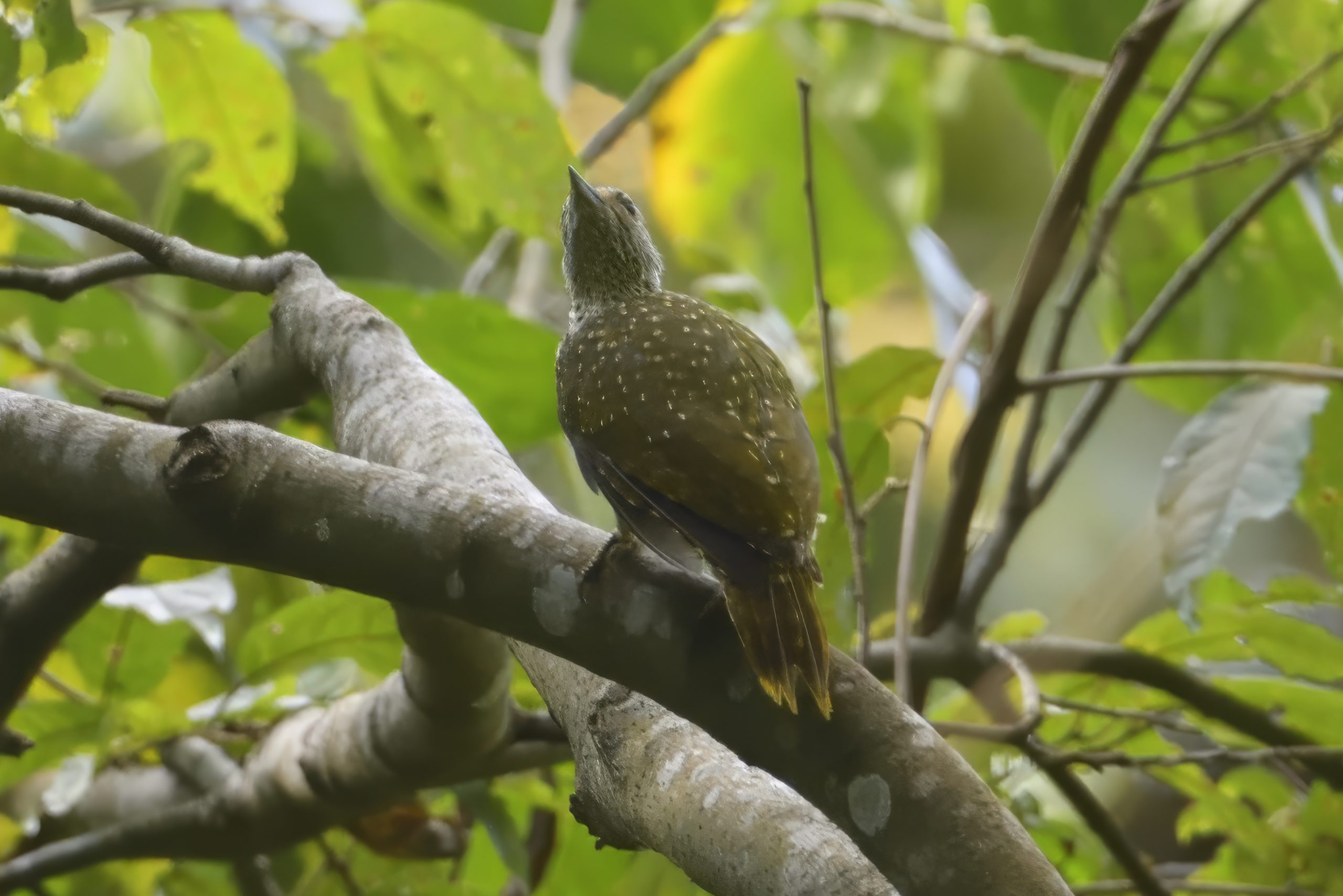
Mombasa Woodpecker, Campethera mombassica, Endemic to Coastal E Africa

Usambara Hyliota, Hyliota usambara, Endemic to Usambara Mountains, Tanzania
Day 17, Thursday, September 26, 2024: Zigi Forest East Usambara to Magamba Forest West Usambara
We packed the car in the morning and started driving towards Zigi Forest. We did not find any new birds there that morning, but stopped at Soni and got East Coast Boubou, Mountain Wagtail, Grey-olive Greenbul and Eastern Golden Weaver. We continued to the gate of Magamba Forest and went to look for the Spot-throat and heard it calling infrequently. We sat up camp and went birding uphill from Camp. Here are some of the birds we registered: Sharpe´s Starling, Hartlaub´s Turaco, Moustached Tinkerbird, Evergreen Forest Warbler, Red-capped Forest Warbler, Olive-headed (Stripe-faced) Greenbul, Estern Bronze-naped Pigeon, African Olive Pigeon, Fülleborn´s Boubou, Mountain Buzzard, Red-faced Crimsonwing, Bar-throated Apalis, Olive Woodpecker, Black-backed Puffback, African Hill Babbler, Waller´s Starling, Usambara Double-collared Sunbird and Southern Yellow White-eye. We returned to camp where I had the local chicken boiling for a while. I added vegatables and made a nice chicken casserole and served it with pasta. We retired early to our tents.
Some pictures from Day 17:

Bar-throated Apalis, Apalis Thoracica, race griseiceps

Waller´s Starling, Onychognathus walleri
Day 18, Friday, September 27, 2024: Magamba Forest Full day.
We had coffee at 06:45. The other left before me so I got a picture of Usambara Thrush while catching up with them. Other new birds on the morning walk included Bar-tailed Trogon and Usambara Akalat. We returned to camp and I made breakfast. After breakfast, we did the forest walk along the lake. We recorded Baglafecht Weaver, Lemon Dove, African Goshawk and Yellow-bellied Waxbill. We had still not found the Usambara Weaver so I made a new plan for the afternoon. We actually took the car down hill and stopped at likely spots. First we found Montane Tiny Greenbul, Then finally at a good spot Usambara Weaver.
We had now cleaned up Magamba Forest except for the White-chested Alethe which we had only heard.
Some pictures from Day 18:

Usambara Thrush, Turdus roehli, Endemic to Usambara and Pare Mountains in TZ

Red-capped Forest Warbler, Artisornis moreaui, Endemic to Eastern Arc Mountains in TZ and N Mozambique

Black Saw-wing, Psalidoprocne pristoptera

Usambara Weaver, Ploceus nicolli, Endemic to Eastern Arc Mountains of Tanzania
Day 19, Saturday, September 28, 2024: Magamba Forest via South Pare Mountains to Elephant morel Same
Joe had showed me excellent field craft earlier on the trip. I had shown him were to get good views of the Spot-throat. I decided to hang back and start packing camp. I took a little walk and snatched a few pictures before I caught up with them. They had excellent views of the Spot-throat. I served breakfast and packed camp and we were soon on our way. Before Same, we swung up towards the site for South Pare White-eye. This bird have been getting harder and harder to get a decent view of since over the last few years, the Pale White-eye have also invaded the area. Here are some birds we observed: Bar-throated Apalis, race pareensis, Black Saw-wing, Red-throated Rock Martin, Harlaub´s Turaco, Olive-headed (Stripe-faced) Greenbul, East Coast Boubou and South Pare White-eye. On the way down we added a Peregrine Falcon.
We returned to the hotel, freshened up and had an evening meal.
Some pictures from Day 19:

Cape Robin-Chat, Dessornis caffer

Olive-headed (Stripe-faced) Greenbul, Arizelocichla striifaces, Endemic to S Kenya and N Tanzania

Mountain Buzzard, Buteo oreophilus, Endemic to NE Africa

Pale White-eye, Zosterops flavilateralis

Peregrine Falcon, Falco peregrinus
Day 20, Sunday, September 29, 2024: Same via dry country near Nyumba ya Mungu and back home to Kiligolf.
We started birding in Same, we had still some birds to get: Here are what we found at my normal spot: Purple Roller, Chinspot Batis, Lesser Striped Swallow, D´Arnaud´s Barbet, Black-headed Oriole, Northern Red-billed Hornbill, White-bellied Go-away-bird, Black-throated Barbet, Brown-tailed Apalis, Orange-breasted Bushshrike, Reichenow´s Seedeater, Eastern Black-headed Batis, Mouse-coloured Penduline Tit, Grey Wren Warbler, Pink-breasted Lark, Pale White-eye, Willow Warbler, European Bee-eater, Barn Swallow, Crowned Hornbill, Von der Decken´s Hornbill, White-rumped Swift, Southern Grosbeak Canary, Black-necked Weaver, White-browed Sparrow-Weaver, Southern Black Flycatcher, Crested Francolin, Spot-flanked Barbet, Black-bellied Sunbird, Scaly Chatterer, Northern Brownbul, Helmeted Guineafowl, African Red-rumped Swallow, Hildebrandt´s Starling, Slate-colored Boubou, Northern Red-fronted Tinkerbird, Nubian Woodpecker and Red-cheeked Cordon-bleu. We went back to the motel, had breakfast and were soon on our way. We stopped at a place Joe had from e-bird, played Pale Prinia one time and it popped up (TZ Lifer for me). We continued to the dry scrubs close to Nyumba ya Mungu Dam and added the folowing species: Blue-capped Cordon-bleu, Somali Bunting, Red-faced Crombec, Eastern Violet-backed Sunbird, Slate-coloured Boubou, Pringle´s Puffback, White-headed Mousebird, Green-winged Pytilia and Red-fronted Prinia. Quite a few lifers for Joe. We started driving home and I dropped Joe in Moshi and the German at a hotel near the airport. I was home in good time before dark after 2.800 km on the road.
Some pictures from Day 20:

Brown-tailed Apalis, Apalis flavocincta

D´Arnaud´s Barbet, Trachyphonus darnaudii, Endemic to NE Africa

Eastern Black-headed Batis, Batis minor, Endemic to NE Africa

Northern Brownbul, Phyllastrephus strepitans, Endemic to NE Africa

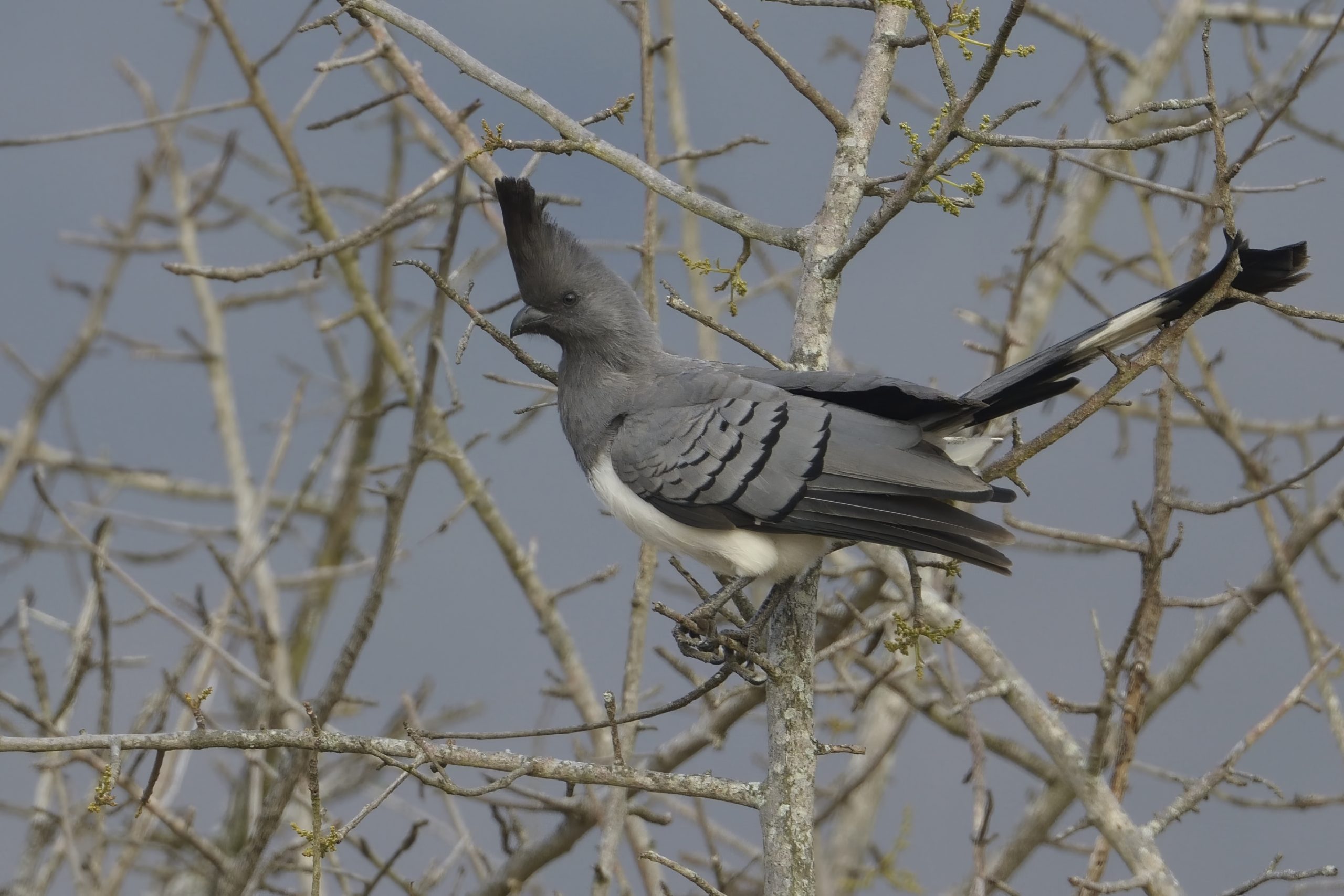
White-bellied Go-away-bird, Crinifer leucogaster, Endemic to NE Africa

Mouse-coloured Penduline-Tit, Anthoscopus musculus, Endemic to NE Africa
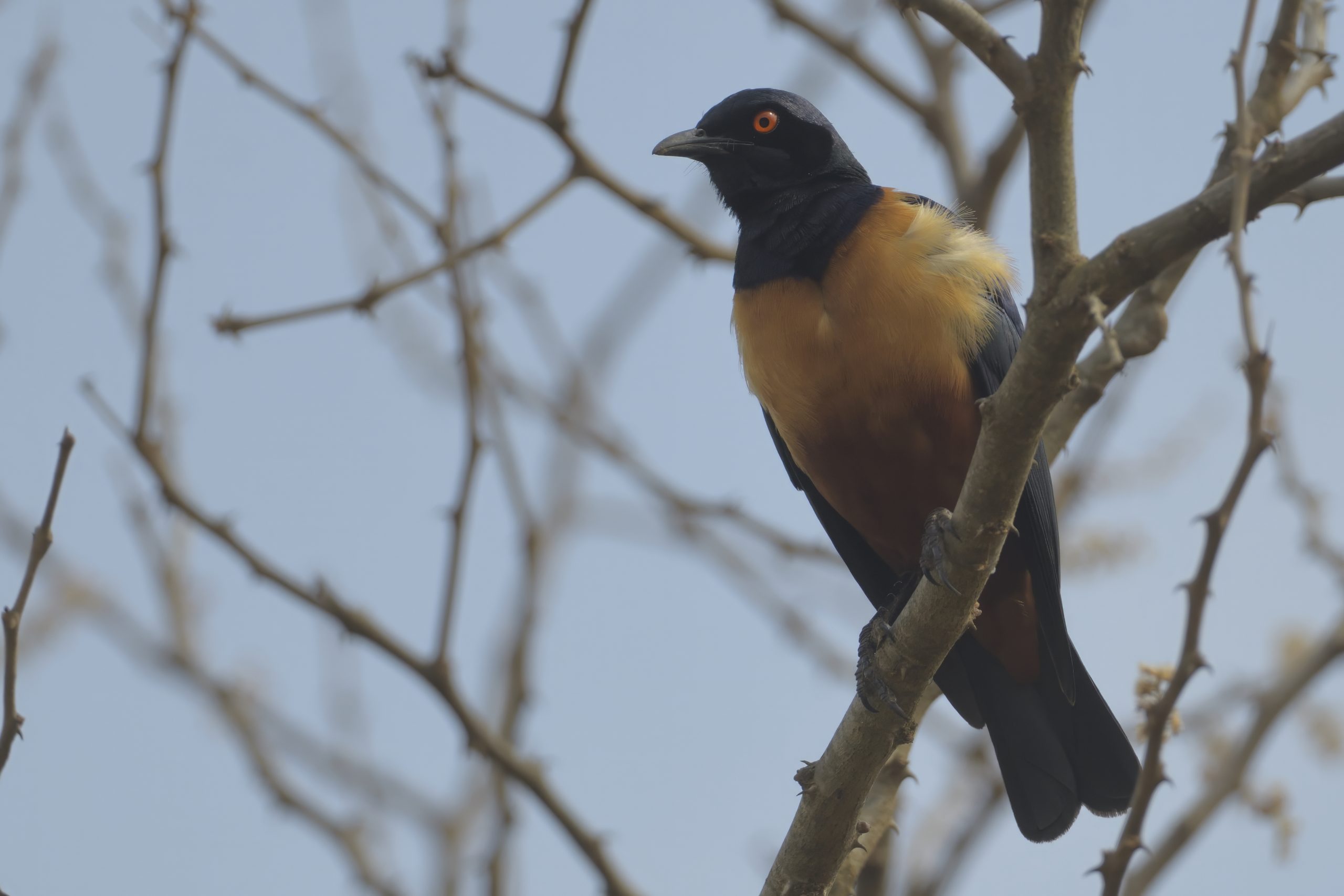
Hildebrandt´s Starling, Lamprotornis hildebrandti, Endemic to E Africa

Spotted Palm Thrush, Cichladusa guttata, Endemic to NE Africa

African Red-rumped Swallow, Cecropis melanocrissus

Black-bellied Sunbird, Notopholia corusca, Endemic to NE Africa
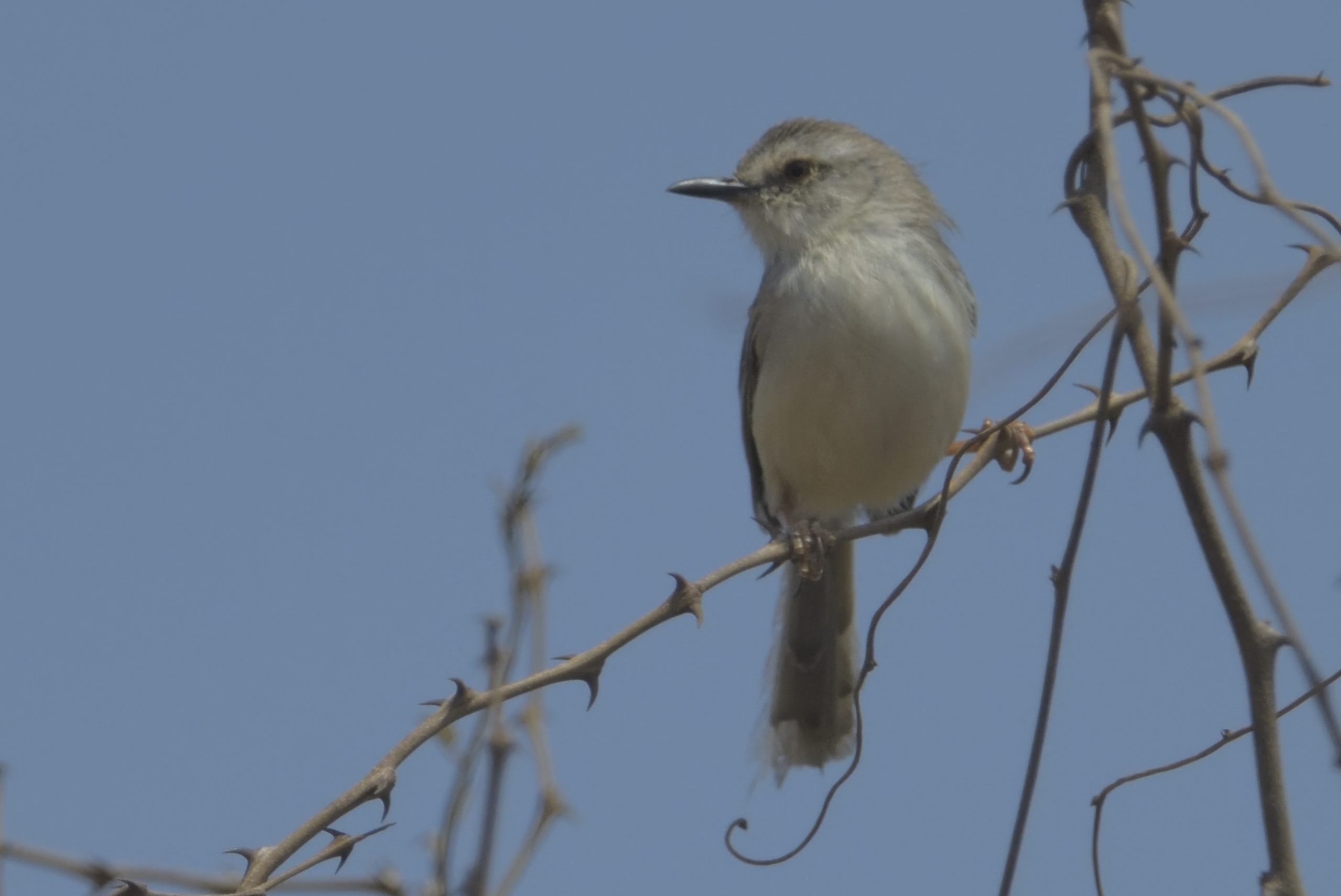
Pale Prinia, Prinia somalica, Endemic to NE Africa (TZ Lifer)
It were the second 3 week TZ trip I did in 2 months. Unfortunately I only had to nights in my own bed before I had to go to Kenya for my next trip. To say the least, my German friend were not a good birder and I ere very disappointed when I found out he was not a Bird Photographer. Ho he could have more then 7-900 birds ww is a mystery for me. Things lighened up quite a bit when Joe Tobias joined up. He was definitively a birder after my taste and showed extremly good field craft and ability to identify birds on his own, where the German were totally helpless. Since we were just looking for the Germans targets, our total list only contained around 470 birds, but as long as he were happy, who am I to complain? Keep posted for a report from my epic 22 day Kenyan I did in October, 2024. I have friends from Norway coming already on November 6, then friends from Iceland on November 26 and then a friend from Norway again on December 28, before I do an 18 day Uganda trip mid January 2025. It is not boring to be retired in Tanzania 🙂